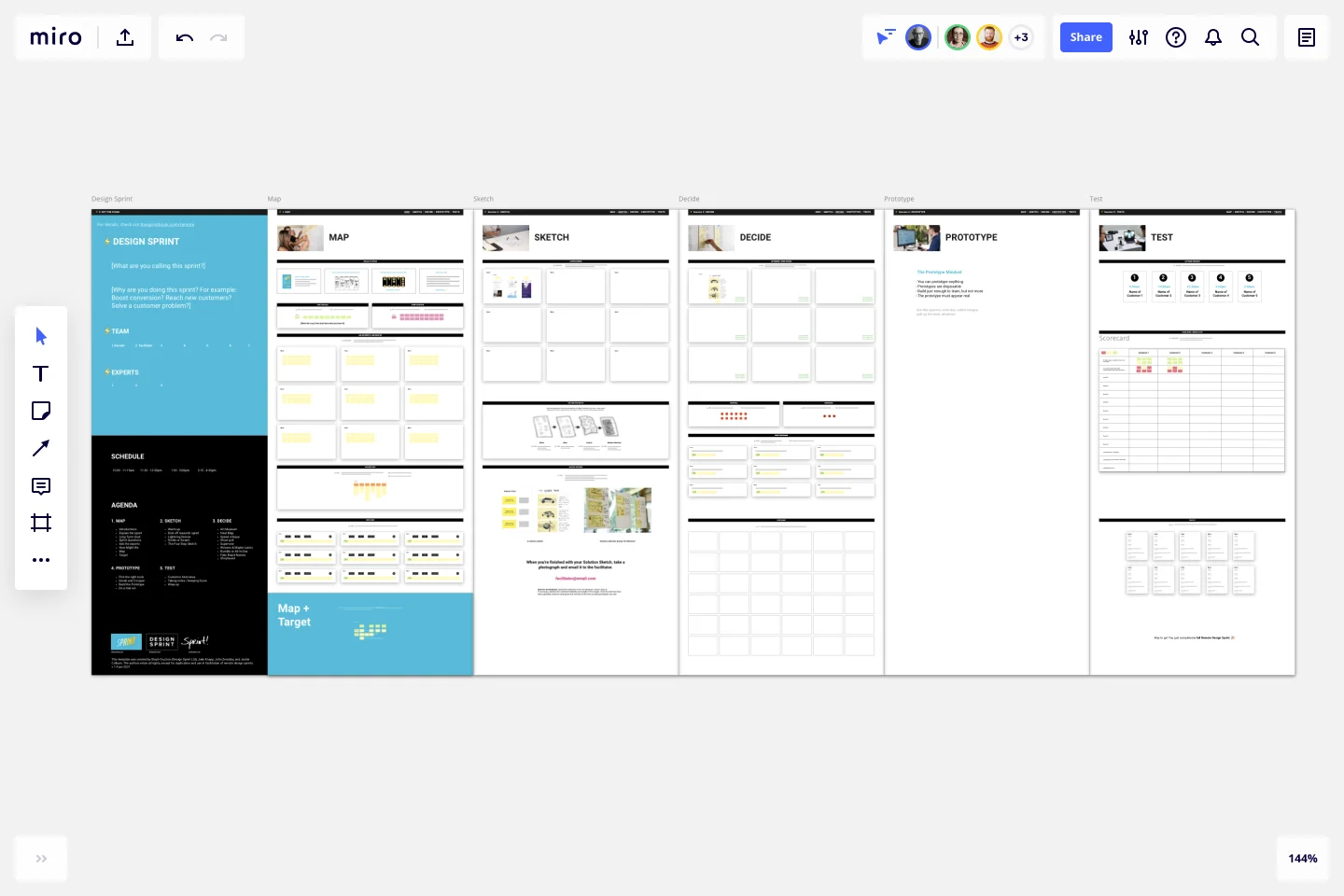Official 5-Day Design Sprint
Use our five-day sprint process to help your team solve problems and test out new ideas.
About the official Remote 5-day Design Sprint template
What Is a Design Sprint?
The big idea with the Design Sprint is to build and test a prototype in just five days. You'll take a small team, clear the schedule for a week, and rapidly progress from problem to tested solution using a proven step-by-step checklist. It's like fast-forwarding into the future.
Why use this Design Sprint template
The experts who literally wrote the book on design sprints created this template, just for Miro. First, facilitator Steph Cruchon of Design Sprint Ltd gathered the agency’s combined experience of physical design sprints and looked for ways to make it efficient and enjoyable in a remote setting. At the same time, the creators of the methodology at Google, Jake Knapp and John Zeratsky, teamed up with Jackie Colburn to write an in-depth guide to run full five-day remote design sprints.
Together, they created this official template for remote sprints, invested personally in writing crystal clear instructions, and even added new exercises that don’t appear in the Sprint book but were part of their workshops. This template works hand in hand with the book and will help you run excellent 100% remote design sprints.
How to use the Design Sprint template
Using the Design Sprint template is easy. Typically how it works is, the facilitator will prep the event before guiding participants through the one big goal for each day of the sprint – to map, sketch, decide, prototype, or test.
For those new to participating in Design Sprints, one of the biggest challenges will be to trust the process. Remember that times it will be overwhelming but that’s part of the process and it’ll all work out.
Miro is the perfect tool to use for your design sprint — remotely or in person. Here’s one way to use it when you're preparing for your next sprint:
Get started by selecting this Design Sprint template.
Read the for advice on tools, preparation, facilitation, and modified tactics.
Give the sprint a name. E.g. “User signup flow.”
Clarify the goal of the sprint. E.g. “To improve the user’s experience as they sign up.”
Ensure you get the right people in the room and assign the roles within the team. Make sure to clarify and brief the role of the facilitator and decider in advance.
Then take the template to the session, because you’re ready to get started!
Invite your team to start collaborating, and don’t forget to share the finished product with the wider company. Be sure to tell everyone about the process and help them understand what you’ve explored and learned about the topic.
How long should design sprints be?
Five days. The design sprint is a **five-day** process for answering critical business questions through design, rapid design prototyping, and testing ideas.
What are the 5 phases of sprint?
Technique training for sprinting can be divided into five areas: starting, acceleration, drive phase, recovery phase, and deceleration
Get started with this template right now.
Root Cause Evaluation Template
When you first encounter a complex situation, it's not common to immediately delve into its underlying causes and effects. Often, we grasp the overall picture but fail to separate the problem from its surrounding circumstances. Root Cause Evaluation provides a method to better understand the interconnected factors that have contributed to the current situation.
Workflow Template
Works best for:
Project Management, Workflows
The digital world requires collaboration, and better collaboration leads to better results. A workflow is a project management tool that allows you to sketch out the various steps, resources, timeline and roles necessary to complete a project. It can be used on any multi-step project, whether it’s a business process or otherwise, and is ideal for plotting out the tangible actions you’ll need to take to achieve a goal and the order in which you need to complete those actions.
Rose Thorn Bud Template
The Rose Thorn Bud Template offers a color-coded approach to examining data and structuring problems. The team is instructed to approach each situation thoroughly, methodically, and analytically. They are motivated to identify a positive experience (pink), a negative experience (purple), and a promising goal or insight (green). Identifying Roses, Thorns, and Buds helps in gaining a better understanding of one's challenges.
App Wireframe Template
Works best for:
UX Design, Wireframes
Ready to start building an app? Don’t just imagine how it will function and how users will interact with it—let a wireframe show you. Wireframing is a technique for creating a basic layout of each screen. When you wireframe, ideally early in the process, you’ll gain an understanding of what each screen will accomplish and get buy-in from important stakeholders—all before adding the design and content, which will save you time and money. And by thinking of things in terms of a user’s journey, you’ll deliver a more compelling, successful experience.
Service Blueprint to connect journey & operations
Works best for:
Research & Design
Connect customer journeys with operational processes using the Service Blueprint by Essence. This template helps you map out service interactions and backend processes, ensuring seamless service delivery. Use it to align teams, identify gaps, and enhance the customer experience. Perfect for visualizing the entire service ecosystem and improving coordination between different service components.
Breakout Group Template
Works best for:
Education, Team Meetings, Workshops
Breakout groups provide an excellent opportunity for teammates to have candid conversations and connect on a more intimate level than is possible during a broader meeting. When you’re in a large group setting, it can be difficult for people to feel safe or comfortable speaking up. In a smaller group, participants can feel safer sharing their ideas. Since the group is more intimate, teams are empowered to participate rather than observe.
